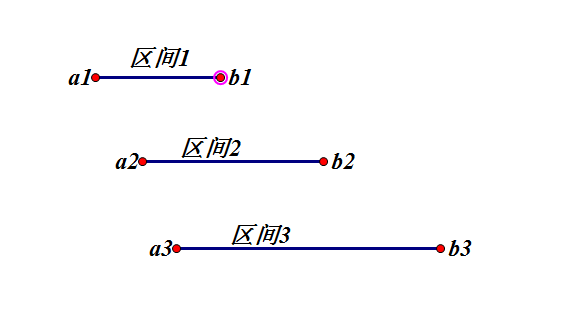首页 > 代码库 > [ACM] POJ 1328 Radar Installation (贪心,区间选点问题)
[ACM] POJ 1328 Radar Installation (贪心,区间选点问题)
Radar Installation
| Time Limit: 1000MS | Memory Limit: 10000K | |
| Total Submissions: 51131 | Accepted: 11481 |
Description
Assume the coasting is an infinite straight line. Land is in one side of coasting, sea in the other. Each small island is a point locating in the sea side. And any radar installation, locating on the coasting, can only cover d distance, so an island in the sea can be covered by a radius installation, if the distance between them is at most d.
We use Cartesian coordinate system, defining the coasting is the x-axis. The sea side is above x-axis, and the land side below. Given the position of each island in the sea, and given the distance of the coverage of the radar installation, your task is to write a program to find the minimal number of radar installations to cover all the islands. Note that the position of an island is represented by its x-y coordinates.

Figure A Sample Input of Radar Installations
We use Cartesian coordinate system, defining the coasting is the x-axis. The sea side is above x-axis, and the land side below. Given the position of each island in the sea, and given the distance of the coverage of the radar installation, your task is to write a program to find the minimal number of radar installations to cover all the islands. Note that the position of an island is represented by its x-y coordinates.

Figure A Sample Input of Radar Installations
Input
The input consists of several test cases. The first line of each case contains two integers n (1<=n<=1000) and d, where n is the number of islands in the sea and d is the distance of coverage of the radar installation. This is followed by n lines each containing two integers representing the coordinate of the position of each island. Then a blank line follows to separate the cases.
The input is terminated by a line containing pair of zeros
The input is terminated by a line containing pair of zeros
Output
For each test case output one line consisting of the test case number followed by the minimal number of radar installations needed. "-1" installation means no solution for that case.
Sample Input
3 2 1 2 -3 1 2 1 1 2 0 2 0 0
Sample Output
Case 1: 2 Case 2: 1
Source
Beijing 2002
题意为,在一个坐标系中,x中代表海岸,x轴以上有n个点,代表着n个岛屿,在x轴上建雷达,一直雷达的覆盖范围为半径为d的圆,求在x轴上最少建多少个雷达,才能把全部的岛屿覆盖起来,如果不能覆盖,输出-1.
区间选点问题为 给定 n个闭区间,求在里面选择最少的点使得每个区间里面都包含至少一个点(一个点可以在不同的区间)。 比如下图。

贪心策略为 把n个区间先按照右端点从小到大进行排序,如果端点相同,按照左端点从大到小进行排序。首先选择第一个区间的右端点。如果以后的区间左端点大于当前选择的端点值时,使得当前选择的端点值改变为这个以后的区间的右端点值。 比如 当前temp是 23 遇到一个区间左端点 25 右端点 27,让temp=27.(选择了一个新点)
回到本题上来,要求建造最短的雷达。 首先对n个岛屿进行画圆,与x轴有两个交点,这样每个岛屿都对应了一个区间(只要雷达建在这个区间内,该岛屿就一定能被覆盖到)。圆的方程(x-a)2+(y-b)2=r2 ,在本题中,b始终是0,因为在x轴上。判断无解的条件为r<y 。我们得到了n个区间,这样问题也就转化为了在这n个区间里面选择尽可能少的点,使得这n个区间中每个区间都至少有一个点。 按照上面的方法做就可以了。
参考:
http://blog.csdn.net/dgq8211/article/details/7534776
代码:
#include <iostream>
#include <string.h>
#include <algorithm>
#include <cmath>
using namespace std;
const int maxn=1010;
struct N
{
double l,r;
}interval[maxn];
bool cmp(N a,N b)//排序
{
if(a.r<b.r)
return true;
else if(a.r==b.r)
{
if(a.l>b.l)
return true;
return false;
}
return false;
}
int main()
{
double x,y;
int n,d;
int c=1;
while(cin>>n>>d&&(n||d))
{
bool ok=1;
for(int i=1;i<=n;i++)
{
cin>>x>>y;
double temp=d*d-y*y;
if(temp<0||d<0)//这样的话就得判断d是否小于0,如果 temp= d-y 这样写的话,就不用判断d是否小于0,坑啊!!
ok=0;
else if(ok)
{
interval[i].l=x-sqrt((double)d*d - (double)y*y);
interval[i].r=x+sqrt((double)d*d - (double)y*y);
}
}
if(!ok)
{
cout<<"Case "<<c++<<": "<<-1<<endl;
continue;
}
sort(interval+1,interval+1+n,cmp);
int cnt=1;
double temp=interval[1].r;
for(int i=2;i<=n;i++)
{
if(temp<interval[i].l)
{
cnt++;
temp=interval[i].r;
}
}
/* for(int i=2;i<=n;i++)
{
if(interval[i].l>temp)
{
cnt++;
temp=interval[i].l;
}
}*/ //一开始写成了这个,不对 比如区间 [1,2] [4,8] [6,9],正确的应该是选择2,8这两个点,而上面这个则选择了 2,4 6,显然不对
cout<<"Case "<<c++<<": "<<cnt<<endl;
}
return 0;
}
声明:以上内容来自用户投稿及互联网公开渠道收集整理发布,本网站不拥有所有权,未作人工编辑处理,也不承担相关法律责任,若内容有误或涉及侵权可进行投诉: 投诉/举报 工作人员会在5个工作日内联系你,一经查实,本站将立刻删除涉嫌侵权内容。
